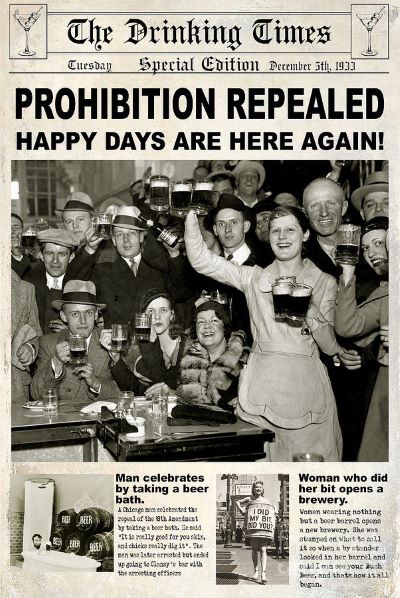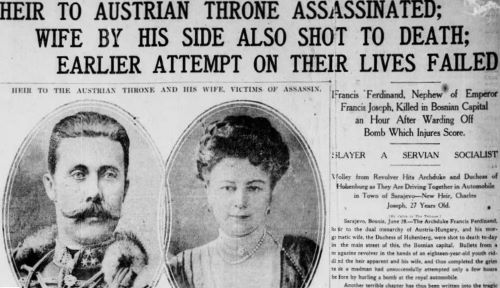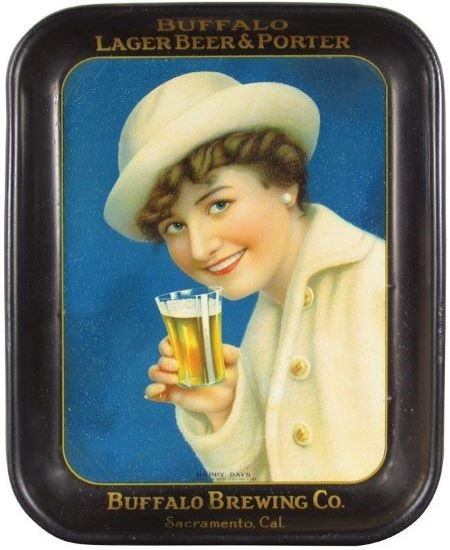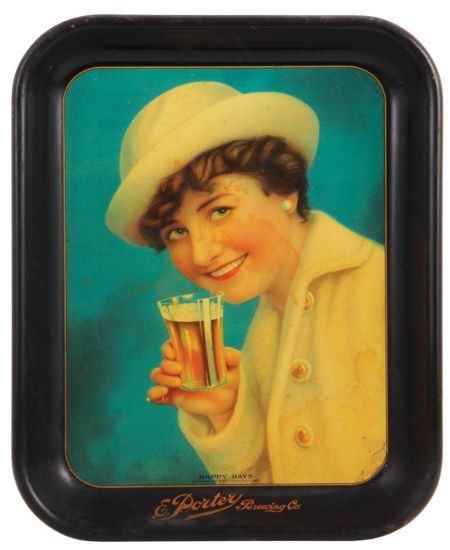The 'Stock' Exchange
American Art Works: No. 147 "Happy Days"
American Art Works: No. 147 "Happy Days"
Date: 1918 to 1925
Size: 10.5" x 13.5"
Type: Pie
Scarcity: Uncommon
Value: $$ to $$$
Condition & Brewer Dependent
Size: 10.5" x 13.5"
Type: Pie
Scarcity: Uncommon
Value: $$ to $$$
Condition & Brewer Dependent


General Comments
For a while, No. 147 "Happy Days" confounded us, probably because we associated the phrase “Happy Days” with the return of beer (and alcohol more broadly) after prohibition. In this we were likely influenced by the song “Happy Days are Here Again.”
For a while, No. 147 "Happy Days" confounded us, probably because we associated the phrase “Happy Days” with the return of beer (and alcohol more broadly) after prohibition. In this we were likely influenced by the song “Happy Days are Here Again.”
Happy days are here again,
The skies above are clear again
Let us sing a song of cheer again
Happy days are here again,
The skies above are clear again
Let us sing a song of cheer again
Happy days are here again,

However, the song, with music by Milton Ager and lyrics by Jack Yellen was not written until 1929 and there are at least a few designs after this one that have dates earlier than that. Reputedly the version sung following repeal of prohibition was modified to “happy days are beer again…” The song entered the popular canon and became a standard that has been interpreted by various artists. It appeared in the 1930 film Chasing Rainbows and was the campaign song for Franklin D. Roosevelt's 1932 presidential campaign, becoming for many years the unofficial anthem of Roosevelt’s Democratic Party.


There was a short-lived Broadway musical theater play by this title that ran at the Hippodrome Theatre from August 1919 to May 1920 that ended up being suspended due to an Actors Equity strike. It did feature a song entitled “Happy Days” however, we have been unable to find any information about the plot or the lyrics to this song. It wasn’t until we delved into the film Chasing Rainbows that we understood the possible context for this title. Although the film seems to be a fairly conventional (for the time) romantic musical, it is set against the backdrop of “the Great War Armistice.”
The Great War or War to End All Wars as it was referred to then, began following the June 1914 assassination of Archduke Franz Ferdinand, the Austro-Hungarian heir, by Gavrilo Princip, a Bosnian Serb separatist. The interlocking alliances between “the Great Powers” were divided into two opposing alliances, the Triple Entente, consisting of France, Russia, and Britain, and the Triple Alliance, made up of Germany, Austria-Hungary, and Italy. On 28 July, Austria-Hungary declared war on Serbia; Russia came to Serbia's defense and by 4 August, the conflict had expanded to include Germany, France and Britain, along with their respective colonial empires. In November, the Ottoman Empire, Germany and Austria formed the Central Powers, while in April 1915, Italy joined Britain, France, Russia and Serbia as the Allied Powers. Early on the war was greeted enthusiastically by all sides, most of whom assumed they’d be victorious in a matter of months. Nobody envisioned a conflict that would drag on for 4 years and cost over 9 million combatants and 5 million civilians. The United States entered the war in April 1917 after prolonged effort by President Woodrow Wilson, although it had long been a supplier to the Allied nations. To Wilson, the war represented the climax of the Progressive Era as it sought to bring reform and democracy to the world. There was substantial public opposition to U.S. entry into the war.
It is our belief that this design was release following the announcement of peace and/or the Armistice (officially November 11, 1918), thus making sense of the title “Happy Days.” This would also explain the relatively few users of this design, as by this time the push for Prohibition was well underway with many states already having ratified the 18th Amendment and passed state prohibition laws. Ratification became official in January 16th, 1919 when the 36th state approved the measure (there were five states that approved it on this date so it’s a matter of debate which one pushed it over the top). Only two states, Connecticut and Rhode Island—opted out of ever ratifying it. On October 28, 1919, Congress passed enabling legislation, known as the Volstead Act, to enforce the Eighteenth Amendment when it went into effect in 1920. As such, we believe this is the last pre-prohibition stock beer design by American Art Works, although it is possible that the as-yet still unidentified No. 148 may have been one too.
As noted in discussions of previous designs, World War I had a profound effect on fashions, in part due to the unavailability of materials and supply chain issues, tending toward simpler and more practical designs than the pre-war Edwardian age. This was also influenced by the need for women to enter the workforce, particularly in the manufacturing sector, to replace the labor of men who went off to combat. While her outfit is still clearly “nice” the hat and cloth coat are far simpler than on previous designs.
Sahling's Design Notes
Sahling does not have an entry in his workbook for this design, nor have we seen one with an artist’s signature.
Size, Shape and Message Placement
Every example we’ve seen of this design has been a small oblong (11x14), although admittedly they have been from only two advertisers—Buffalo Brewing of Sacramento, CA and E Porter Brewing of Joliet, IL. Rims are black with gold advertising text, neither of which have any advertising on the face of the tray.
Hager & Price
Hager stopped commenting on specific trays after No. 136 and he does not include this in his date of introduction table; we speculate that is because all examples we’ve seen only carry the © symbol along with the stock number but no specific date. He does include it in his catalog with the correct stock number. Prices for average and below examples rarely achieve more than two figures, but even above average examples usually only achieve low triple figures.
The Great War or War to End All Wars as it was referred to then, began following the June 1914 assassination of Archduke Franz Ferdinand, the Austro-Hungarian heir, by Gavrilo Princip, a Bosnian Serb separatist. The interlocking alliances between “the Great Powers” were divided into two opposing alliances, the Triple Entente, consisting of France, Russia, and Britain, and the Triple Alliance, made up of Germany, Austria-Hungary, and Italy. On 28 July, Austria-Hungary declared war on Serbia; Russia came to Serbia's defense and by 4 August, the conflict had expanded to include Germany, France and Britain, along with their respective colonial empires. In November, the Ottoman Empire, Germany and Austria formed the Central Powers, while in April 1915, Italy joined Britain, France, Russia and Serbia as the Allied Powers. Early on the war was greeted enthusiastically by all sides, most of whom assumed they’d be victorious in a matter of months. Nobody envisioned a conflict that would drag on for 4 years and cost over 9 million combatants and 5 million civilians. The United States entered the war in April 1917 after prolonged effort by President Woodrow Wilson, although it had long been a supplier to the Allied nations. To Wilson, the war represented the climax of the Progressive Era as it sought to bring reform and democracy to the world. There was substantial public opposition to U.S. entry into the war.
It is our belief that this design was release following the announcement of peace and/or the Armistice (officially November 11, 1918), thus making sense of the title “Happy Days.” This would also explain the relatively few users of this design, as by this time the push for Prohibition was well underway with many states already having ratified the 18th Amendment and passed state prohibition laws. Ratification became official in January 16th, 1919 when the 36th state approved the measure (there were five states that approved it on this date so it’s a matter of debate which one pushed it over the top). Only two states, Connecticut and Rhode Island—opted out of ever ratifying it. On October 28, 1919, Congress passed enabling legislation, known as the Volstead Act, to enforce the Eighteenth Amendment when it went into effect in 1920. As such, we believe this is the last pre-prohibition stock beer design by American Art Works, although it is possible that the as-yet still unidentified No. 148 may have been one too.
As noted in discussions of previous designs, World War I had a profound effect on fashions, in part due to the unavailability of materials and supply chain issues, tending toward simpler and more practical designs than the pre-war Edwardian age. This was also influenced by the need for women to enter the workforce, particularly in the manufacturing sector, to replace the labor of men who went off to combat. While her outfit is still clearly “nice” the hat and cloth coat are far simpler than on previous designs.
Sahling's Design Notes
Sahling does not have an entry in his workbook for this design, nor have we seen one with an artist’s signature.
Size, Shape and Message Placement
Every example we’ve seen of this design has been a small oblong (11x14), although admittedly they have been from only two advertisers—Buffalo Brewing of Sacramento, CA and E Porter Brewing of Joliet, IL. Rims are black with gold advertising text, neither of which have any advertising on the face of the tray.
Hager & Price
Hager stopped commenting on specific trays after No. 136 and he does not include this in his date of introduction table; we speculate that is because all examples we’ve seen only carry the © symbol along with the stock number but no specific date. He does include it in his catalog with the correct stock number. Prices for average and below examples rarely achieve more than two figures, but even above average examples usually only achieve low triple figures.

Confirmed Brewer used Stock Trays
Non-Beer Related & Non-Tray Uses
Click the Picture to Return to Meek & Beach Stock Catalog Page



